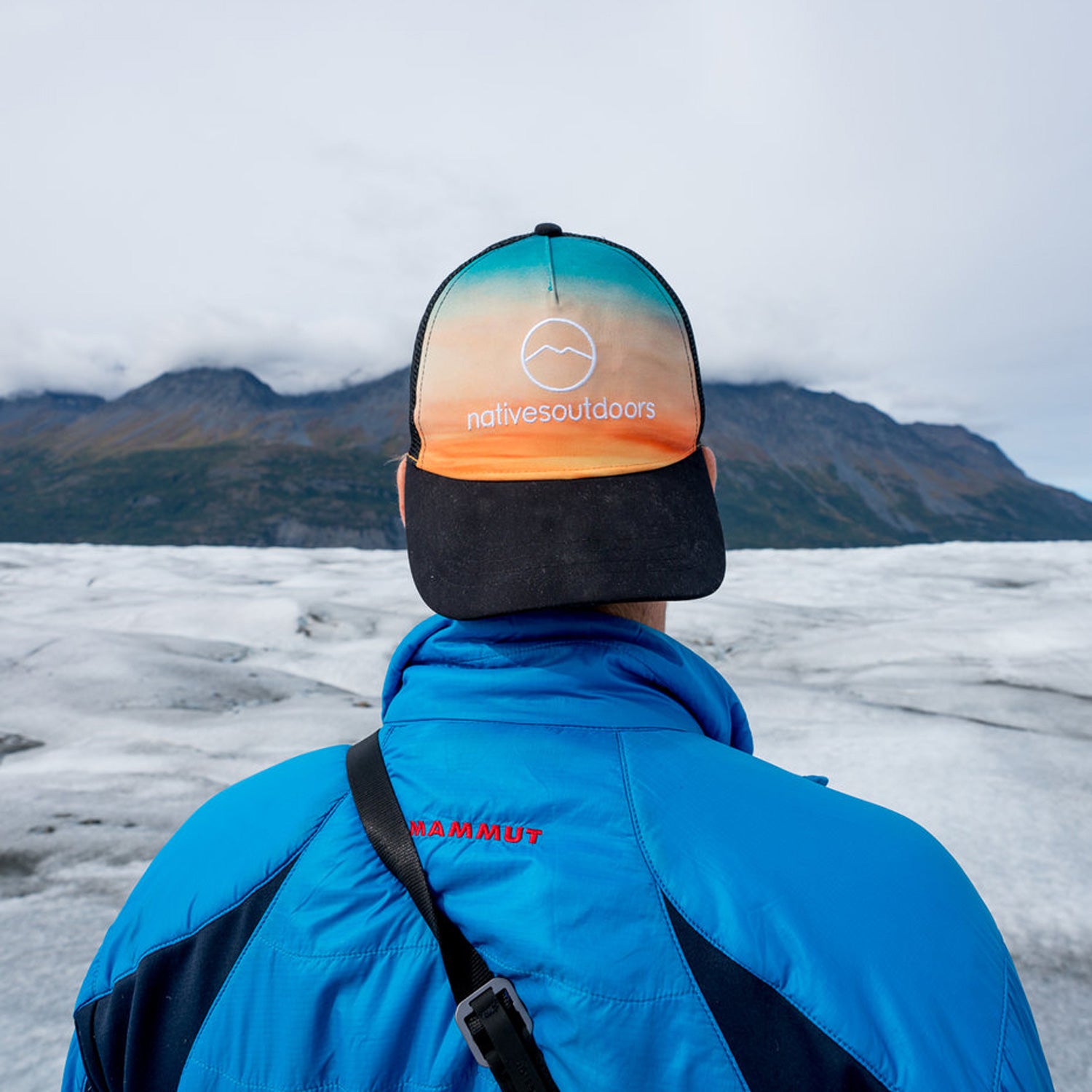When graphic designer Vernan Kee received an invitation to the winter Outdoor Retailer market in January 2017, he jumped at the chance to attend, hoping the opportunity would help him advance his career and build his client base. Like most Outdoor Retailer rookies, he was initially blown away by the innovative product designs and outdoor merchandise displayed by brand after brand. Outdoor Retailer is, among many other things, a chance for brands to debut new product lines and show off a bit.
But the more products and brands Kee saw, the worse he felt about pursuing work in the outdoor industry.
Kee is Diné, or Navajo. As he walked among the flashy booths, he saw the designs of his people plastered on everything from scarves to snowboards. Symbols like the sacred Dinétah diamonds that symbolize the four corners of the Navajo Nation, the traditional Spider Woman crosses that honor the culture’s history as weavers, and the sun-face graphics that symbolize prosperity were being used with no respect for their traditional meanings.
“I tried ignoring it at first, but it just got worse. Almost every brand had something Native American–related,” says Kee, who had at various points approached some of the brands for work but had never been hired. “A lot of them were using actual symbols that are sacred and mean something.”
This uncredited adoption of imagery and symbols has a name: cultural appropriation. Outdoor brands, like countless clothing, bedding, and furniture manufacturers before them, have put Native imagery on all sorts of apparel and technical gear for years. Only a fraction of that imagery has been created by Indigenous designers and artists. The problem is especially ironic as the outdoor industry has aligned itself with tribal interests in protecting public lands, from Bears Ears National Monument to the Arctic National Wildlife Refuge. It’s time to elevate the work of Native people who are fully capable of creating that aesthetic on their own and have been doing it for untold generations before white people realized how good these designs look on Instagram.
“Let’s face it,” says Shain Jackson, a Coast Salish artist and lawyer based in British Columbia, “we are the most impoverished demographic in this country. Our artwork, nationwide, is our biggest source of private direct revenue. Handcrafts, arts, and designs are hardly scratching the surface, but we just want the benefit from the artwork to go to the right people, or at least a large part of it.”
Mainstream—that is, mostly white—culture continues to steal from and profit off Indigenous people who have already lost land, language, culture, and countless lives to colonialism and cruel policies. Using meaningful Native images on products simply for aesthetic reasons is a way of ignoring the context of colonialism and stolen lands. The trendiness of Native imagery compounds the problem even further by making it harder for talented, motivated Native people like Kee to break into the industry.
“We’re not stuck in the Stone Age,” Kee says. “I graduated with a bachelor’s degree in graphic design, and I’m implementing traditional designs in modern, artistic ways.” Kee’s client list includes NativesOutdoors, a B-Corp organization that works to support Indigenous people in the outdoor industry and beyond. (NativesOutdoors was founded by Len Necefer, a co-author of this article.)
This problem extends far beyond the outdoor industry, but it’s worth scrutinizing especially as outdoor brands publicize their politics, as they did in 2017, when Outdoor Retailer moved from Salt Lake City to Denver in protest of Utah’s position on public lands. Brands walk a fine line between a white savior complex and true allyship when they ignore other injustices in how they treat Indigenous cultures and artwork.
“Part of reconciliation is being honest about the history that is difficult to hear,” says Gregg Deal, a Native activist and artist who is very vocal about the relationship between Indigenous identity and pop culture. “And knowing your history isn’t just like saying, ‘I know Indians got a raw deal.’ Look at something like the Sand Creek Massacre,” in 1864, when U.S. soldiers raided a Cheyenne and Arapahoe village, killing hundreds. “Once you have that context, then you understand things like historical trauma.”
It’s time to elevate the work of Native people who are fully capable of creating that aesthetic on their own and have been doing it for untold generations before white people realized how good these designs look on Instagram.
The outdoor industry, which is already making strides in upholding stringent guidelines in other areas, such as sustainability�����Ի���������ھ��� standards on feather sourcing for down products, could give the same treatment to ethical standards when it comes to Native designs. “A good ally is someone who facilitates the opportunity for our people to speak for ourselves,” Deal says.
Customers should ask questions and make sure they’re spending money on real Indigenous designs, Jackson says. “Ask if an Indigenous design on a product is not only a real Indigenous design, but also if the artist has been remunerated for that design,” he says.
Over the past year, Jackson has partnered with Mountain Equipment Co-Op, Canada’s version of REI, to help the retail chain set standards of fairness to Indigenous artists. He educated MEC staff about the impact of cultural appropriation as the co-op began to remove products from its inventory that used Indigenous imagery but weren’t created by Natives.
“For me, it’s been an incredible learning journey,” says Shona McGlashan, MEC’s chief governance officer and internal leader of the company’s effort to remove appropriated designs from its shelves. “The first two or three times this question came up to me, I was like, ‘Yeah, this is no big deal.’ It has taken me a while to understand what I currently understand. You have to confront things that you were doing in the past that you maybe don’t feel that great about.”
MEC has been relatively quiet about this new policy, but the company now asks each brand it carries to prove a Native artist was financially compensated before placing an item with Indigenous symbols or graphics on its shelves.
If this sounds like a lot of work, it is. “It’s hard for people like me to confront the shoulders they’re standing on. It’s very uncomfortable, and it’s very necessary,” McGlashan says. “There are a lot of gray areas. If it was an easy question to have solved, we would have solved it.”
Still, consider that the outdoor industry contributes $373 billion to the U.S. economy, and brands have been known to brainstorm very long lists of potential product names for each jacket in their line. Why not put the same effort into making sure Native designs are properly used? Treating Native artists fairly isn’t a simple process, but that doesn’t mean that the line between right and wrong is blurry.
“There are things that somebody will consider egregious appropriation and others will think is fair artistic game,” McGlashan says. “When people say a product is ‘inspired’ by something, that’s already a red flag that has my ears pricking up. One of the things that I will say in my work on this subject is that art absolutely exists to challenge and critique society. Outdoor retail, not so much.”
Indigenous artists like Kee are ready to make their voices heard—with or without the support of larger brands and other potential allies. Toward this goal, with the Colorado Commission of Indian Affairs and the Colorado Outdoor Recreation Industry Office to gather 20 tribes’ elected officials at this summer’s Outdoor Retailer show to discuss their involvement with the outdoor industry and public land management. This gathering is the first of its kind and will create a bridge between the industry and the tribes.
“I really wanted to make the industry aware that there are Native Americans here now—at Outdoor Retailer, in the outdoor industry, and purchasing products as outdoor consumers,” Kee says. “These brands should just be aware of that. Things need to change a little bit around here.”



